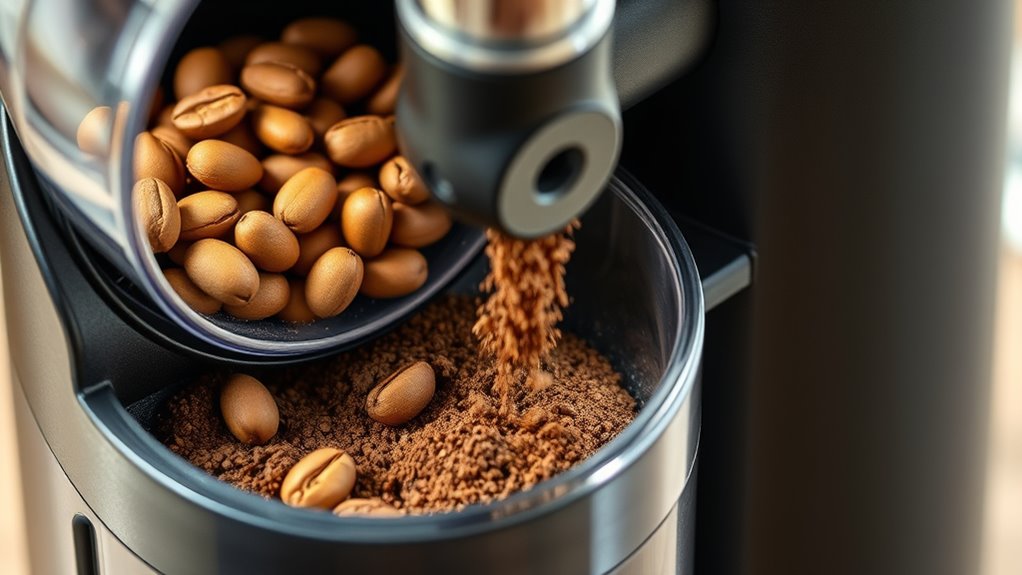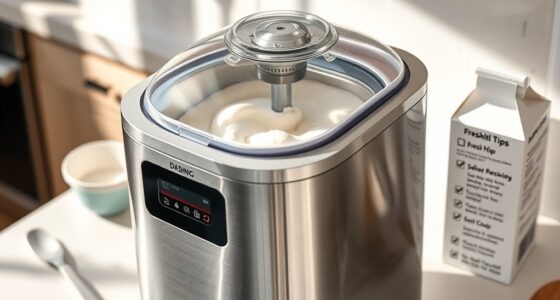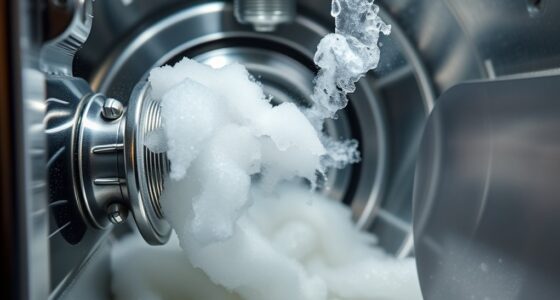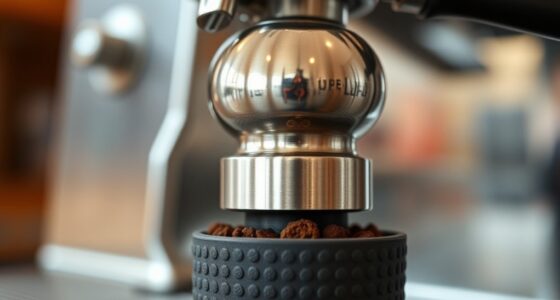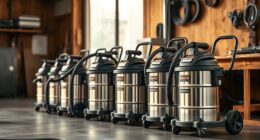To select the best coffee grinder for your needs, consider your preferred brewing method and the grind size it requires. Burr grinders with adjustable settings provide consistency and versatility, whether you make espresso, French press, or drip coffee. Think about your budget, durability, ease of cleaning, and noise level. High-quality burrs ensure a uniform grind, enhancing flavor. Want to find the perfect match for your coffee routine? Keep exploring to discover more helpful tips and options.
Key Takeaways
- Determine your preferred brewing method to select the appropriate grind size and grinder type.
- Consider grind consistency, adjustable settings, and burr quality for optimal flavor extraction.
- Assess ease of cleaning, maintenance, and static reduction features for long-term performance.
- Balance your budget with essential features, brand reputation, and warranty options.
- Evaluate noise level, portability (manual vs. electric), and additional features like built-in scales or timers.
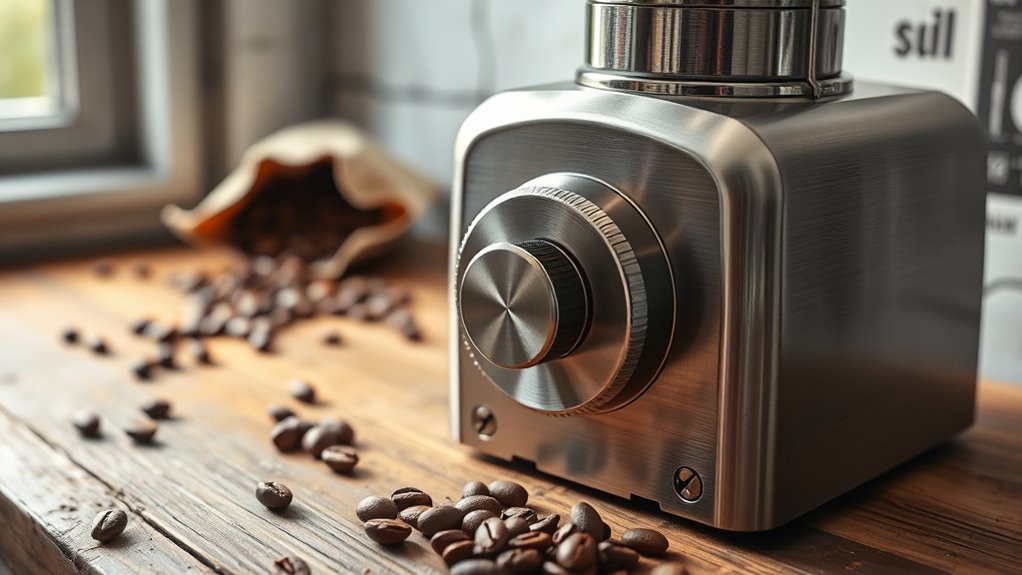
Choosing the best coffee grinder can considerably enhance your brewing experience, whether you prefer a quick espresso or a slow French press. The right grinder ensures your coffee grounds are uniform, which directly impacts flavor extraction and overall taste. To find the best fit, start by understanding the different types available.
Choosing the right coffee grinder elevates your brewing, ensuring uniform grounds for better flavor and extraction.
Burr grinders, for example, provide consistent grind sizes and are versatile enough for various brewing methods. They come in two main styles: conical and flat burrs. Conical burrs excel at producing fine grinds, making them ideal for espresso, while flat burrs handle coarser grinds better, perfect for French press or cold brew. Blade grinders, on the other hand, use spinning blades and are less expensive but often produce uneven grounds, leading to inconsistent flavor.
Manual grinders offer control over the grind size and are portable, making them great for travel or outdoor use, but they require more effort and time. Electric grinders are faster and more convenient, suited for daily use, though they may generate heat that can affect flavor and often produce more noise.
Once you understand the types, consider key features that match your brewing style. Adjustable grind settings are essential for switching between espresso, pour-over, drip, or French press. Look for grinders with durable burrs—stainless steel or ceramic—as they last longer and maintain consistent performance.
Ease of cleaning is also imperative; removable parts and built-in brushes simplify maintenance and prevent flavor transfer caused by old coffee oils. Noise level matters if you’re brewing early in the morning or in shared spaces; some models are designed to operate quietly. Price varies widely, so determine your budget beforehand.
While high-end models offer superior durability and features, many affordable options still deliver good performance. Grind consistency and control are indispensable for brewing quality coffee. An adjustable grind size allows you to tailor your grounds precisely, and high-quality burrs ensure uniformity.
The grind container should be easy to remove and clean, and some grinders incorporate static reduction features to minimize mess. If accuracy matters to you, consider models with built-in scales for precise measurement. Also, think about your brewing method—espresso demands a very fine grind, while French press needs a coarse one. A grinder that offers multiple settings will give you the flexibility to experiment.
Maintenance is simple when you choose a grinder with removable parts and a cleaning brush. Regular cleaning prevents buildup and preserves flavor, while drying after cleaning prevents rust. For safety, opt for models with safety features and certifications like UL or ETL.
Additionally, selecting a grinder with consistent performance can significantly improve your coffee quality over time. Electric grinders consume more power but save time, while manual options require effort but offer portability. When selecting, review brands like Baratza and OXO, which are known for quality and durability. Read reviews and ratings to gauge performance, and check warranty options to protect your investment.
Ultimately, choosing the right coffee grinder involves balancing your brewing needs, budget, and preferences for control, convenience, and maintenance.
Frequently Asked Questions
Can a Coffee Grinder Improve the Flavor of My Coffee?
Yes, a coffee grinder can definitely improve your coffee’s flavor. When you grind fresh beans, you increase surface area, releasing more aroma and flavor compounds.
Using a high-quality burr grinder guarantees consistent particle size, leading to even extraction and a balanced taste.
Plus, on-demand grinding preserves freshness and volatile aromas.
How Often Should I Clean My Coffee Grinder?
You should clean your coffee grinder every 2 to 6 weeks, depending on how often you use it and the type of beans you grind.
For daily use, clean every 2 weeks or weekly if you’re using oily beans.
Light roasts need less frequent deep cleaning, maybe every 2-3 months, while dark roasts require monthly cleaning.
Regular cleaning prevents oil buildup and keeps your coffee tasting fresh.
Is a Burr Grinder Better Than a Blade Grinder?
You wonder if a burr grinder is better than a blade grinder. Generally, yes. Burr grinders produce uniform grounds, which lead to better flavor extraction and consistency. They also cause less heat, preserving aroma and subtle notes.
While they cost more and require more maintenance, burr grinders are worth it if you care about taste and quality. Blade grinders are simpler and cheaper but may compromise flavor due to uneven grinding.
What’S the Ideal Grind Size for Different Brewing Methods?
You should match your grind size to your brewing method for the best results. For cold brew and French press, opt for extra coarse or coarse grounds.
Use a medium grind for drip coffee.
And a medium-fine grind for pour-over.
If you’re making espresso, go for a fine grind.
Consistency matters, so choose a grinder that produces uniform grounds, ensuring proper extraction and rich flavor every time.
Do Coffee Grinders Affect Caffeine Content?
Imagine the tiny coffee particles dancing in your cup, each one releasing caffeine as hot water drapes over them. Yes, your grinder affects caffeine content—an efficient burr grinder with adjustable settings ensures consistent, fine grounds that extract more caffeine.
A cooler operation preserves flavor and caffeine levels, while uneven grinding or heat buildup can diminish both. So, choose a grinder that’s precise and steady to maximize your caffeine kick.
Conclusion
Now that you know what to look for, aren’t you excited to find the perfect grinder that makes every cup special? Remember, the right grinder isn’t just about features—it’s about creating moments of joy with every brew. So, why settle for anything less than the best? Pick the grinder that matches your needs, and turn your coffee routine into a daily celebration. After all, isn’t your perfect cup worth it?
